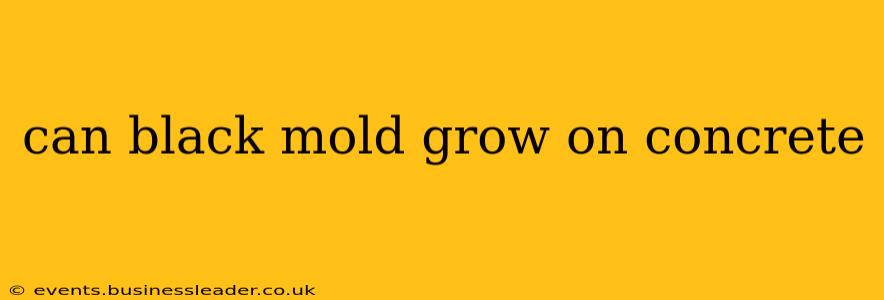Yes, black mold, or more accurately, Stachybotrys chartarum (and other mold species), can grow on concrete. While concrete is a relatively inert material, it's not impervious to mold growth. Several factors determine whether or not mold will thrive on a concrete surface. Understanding these factors is crucial for prevention and remediation.
What Conditions Allow Black Mold to Grow on Concrete?
Mold needs three key elements to grow: moisture, a food source, and the right temperature. Let's break down how these factors relate to concrete:
1. Moisture: This is the most critical factor. Concrete, especially in damp environments, can retain moisture. Leaks, high humidity, flooding, or even condensation can create the perfect breeding ground for mold. Porous concrete, which is common in older structures, absorbs and retains moisture more readily than denser, newer concrete.
2. Food Source: Mold feeds on organic matter. This could be anything from dust and dirt to decaying wood, drywall fragments, or even residues left behind from spills or cleaning products. Even seemingly clean concrete can have enough organic matter to support mold growth given sufficient moisture.
3. Temperature: Mold thrives in temperatures between 77°F and 86°F (25°C and 30°C). While most areas experience temperatures within this range at some point, prolonged exposure is key.
How Does Black Mold Appear on Concrete?
Black mold on concrete typically appears as dark, slimy patches. However, it's important to note that not all black mold is Stachybotrys chartarum. Many other mold species can appear black or dark green. Accurate identification often requires a laboratory test. The mold may appear in cracks, crevices, or on surfaces that have consistently retained moisture.
How to Prevent Black Mold Growth on Concrete
Prevention is always better than cure. Here's how to minimize the risk of black mold on concrete:
-
Control Moisture: This is paramount. Repair any leaks promptly, ensure proper ventilation in damp areas like basements, and address any water damage immediately. Consider using dehumidifiers in areas prone to high humidity.
-
Maintain Cleanliness: Regularly clean concrete surfaces, especially in areas prone to moisture. Remove dust, dirt, and other organic matter.
-
Seal Porous Concrete: Applying a sealant to porous concrete can reduce its ability to absorb moisture, making it less hospitable to mold. Choose a sealant specifically designed for concrete and follow the manufacturer's instructions carefully.
-
Improve Ventilation: Ensure adequate air circulation to reduce humidity and prevent moisture buildup.
What to Do If You Find Black Mold on Concrete
If you suspect black mold growth on concrete, do not attempt to clean it yourself without proper safety precautions. Black mold spores can be harmful if inhaled. Contact a professional mold remediation specialist. They have the expertise and equipment to safely remove the mold and address the underlying moisture problem.
Is Black Mold on Concrete Dangerous?
The potential dangers of black mold on concrete are similar to those associated with black mold in other areas. Exposure to Stachybotrys chartarum and other mold species can trigger allergic reactions, respiratory problems, and in severe cases, more serious health issues. It’s crucial to take any suspicion of black mold seriously.
Can I Clean Black Mold on Concrete Myself?
While you might be tempted to tackle black mold removal yourself, it's strongly advised against. Improper cleaning techniques can spread mold spores and exacerbate the problem. Professional remediation ensures safe and effective removal.
How Do I Identify Black Mold on Concrete?
Visual identification can be tricky. While black or dark green discoloration is a strong indicator, confirmation often requires laboratory testing by a professional. They can identify the specific mold species and determine the extent of the infestation.
This comprehensive guide addresses the concerns surrounding black mold on concrete, offering practical advice for prevention and remediation. Remember, addressing any moisture issues is key to preventing future mold growth.
